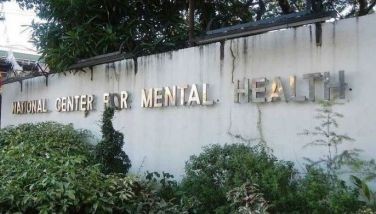Bohol churches still in ruins
CEBU, Philippines - Two years after that fateful day in 2013 when a magnitude 7.2 earthquake jolted the Visayas, particularly the province of Bohol, parishioners of the island are still left hearing masses in alternate and makeshift churches after most of the churches that were reduced to rubble have not been restored.
Devotees may even expect for this scenario to stretch longer as restoration only started last month.
Of the 25 damaged heritage and historical churches in Bohol, only four are currently undergoing actual restoration, said Rev. Fr. Milan Ted Torralba, Chair of the Diocese of Tagbilaran Commission for the Cultural Heritage of the Church.
These heritage churches are found in Tagbilaran, namely the Church of Our Lady of the Assumption in Dauis; Holy Trinity Church in Loay town; San Isidro de Labrador Church in Tubigon; and Bohol’s oldest church and one of the oldest churches of the Philippines, the Our Lady of the Immaculate Conception in Baclayon.
The Diocese of Tagbilaran has identified 25 of its 60 parish churches as heritage churches. Eleven of these are declared by the Philippine Government’s cultural agencies as national cultural treasures, important cultural properties, national historical landmarks. Fourteen are non-declared historic churches while others are categorized as classified modern structures.
Based on the data made by the National Commission for Culture and the Arts (NCCA) Bohol Heritage Task Force, the churches under the Diocese of Tagbilaran, namely Baclayon, Dauis, Loay, and Cortes suffered severely from the quake while those in Maribojoc and Loon were completely ruined. All were declared as national cultural treasures.
Fr. Torralba said restoration of churches would take at least four years to complete, following tedious processes, budget deliberations, comprehensive planning, site development plans and stakeholders meetings, among others.
He said they cannot abruptly re-establish the ruined churches in just a snap, taking into account technical aspects, like detailed engineering studies, and soil boring tests.
“We have to be realistic. We cannot completely recover the original. Heritage is non-renewable. However, since these heritage churches possess architectural and iconographic documentation and conservation management plans, their restoration is feasible; reconstruction is doable,” he said.
He cited that the four identified churches are in phase 3 of the actual structural restoration with retrieval and salvage operation and documentation of recovered cultural materials.
This would take at least eight months before the architectural aspect, which is the second stage of phase 3, to start, he added.
The Church of San Pedro in Loboc is the second oldest church in Bohol. But, there are yet no plans for its restoration, which will be funded by the National Museum.
Among the churches, Loboc is the “most challenging” to restore because its façade was completely destroyed, Torralba disclosed.
“Mas makasaysayon ang Loboc kaysa Baclayon apan pagbalik niini dili sayon. But, we are all optimistic na ma-restore ang tanan balik,” he said. “We will not only be aiming of restoring buildings and churches, but also restoring lives and spiritual lives,” he added.
It was originally built in 1602, but was eventually reduced to ashes. In 1638, a stronger one was built. Located near the river, it has survived a number of floods.
The flooding problem in the area has further weakened the structural integrity of the church that’s why there are options laid down either to restore or build a new one.
He said a geological study and detailed engineering design has to be undertaken to address the pressing issue.
Locals and experts will meet this Friday in Tagbilaran to come up with solutions and tackle concerns and proposals for the churches’ restoration.
Funding
The national government has poured millions for the restoration of the four churches, totaling to about P2.5 billion, broken down into P650 million for phase 2 and P1.4 billion for phase 3.
For the non-declared historical churches, Torralba said the parish committee for properties and management and the committee for cultural heritage will determine and form the scope of work, experts and technical teams, the financial plan and other pre-restoration works.
The heritage advocate further said that funding of the restoration of the churches would be sourced out from private, non-government organizations and donations from international groups.
He cited, for example, the St. Michael the Archangel Parish church of Clarin and Sandingan Island Parish which funding for restoration is from the United States Conference of Catholic Bishops amounting to P57 million and P10 million (of the total P16 million project cost) respectively.
The town of Clarin also launched a fund raising drive dubbed as “Simbahan ko, Tukuron ko” to rebuild their parish church.
The façade and wall behind the sanctuary of the church were left standing after the quake toppled down most part of the structure.
The parish would reportedly need around P30 million to build a new structure.
The Diocese of Tagbilaran, which the Clarin parish church belongs to, is working with Bahay ng Diyos Foundation Inc. to help raise funds for the church construction.
The foundation is also tapping private and government institutions, professionals and technical experts, and parish communities for the reconstruction of the damaged churches in Bohol.
Bahay ng Diyos Foundation reported that the parish community, through the campaign, was able to raise P3 million in 2014, which was utilized to start the reconstruction project.
The construction of the new church already started when The FREEMAN visited the town last week. For the meantime, masses are still held in a makeshift church erected beside the area where the church once stood.
Clarín parish was established in 1924 while its church was built in 1929 and was remodeled in 1991.
In a special report of The FREEMAN for the first commemoration of the October 2013 quake, Tagbilaran Bishop Leonardo Medroso was quoted as saying that two or three of the 12 cultural heritage churches in the Diocese that were destroyed by the tremor could no longer be restored despite the assurance of the national government to fund the restoration process.
Medroso identified the heritage churches in Maribojoc, Loon, and Loboc as among those destroyed because of the quake.
The parish priests in Bohol were also directed by their respective dioceses to construct alternate churches that could house a crowd of 800 to 1, 000.
The same initiative was also taken by Saint Paul the Apostle Parish in Inabanga, the hometown of Francisco Dagohoy. Inabanga church built in 1726 was the only one in the Diocese of Talibon which severely suffered from the quake with more than 50 percent of the structure also caved in, leaving only its façade and the altar.
The reconstruction would cost P30 to P50 million, said Parish Pastoral Council treasurer Virginia Dela Cuesta.
She shared with The FREEMAN that they have raised P5 million to fund the reconstruction. The National Historical Commission of the Philippines also committed P25 million for the project.
She said more donations are also coming from the private organizations and firms.
A stakeholders’ meeting was held last October 7, 2015 wherein the implementation of the reconstruction project to be undertaken by NHCP was discussed.
Dela Cueste said they are hoping that the project would start before the year ends.
An alternate church situated beside the wrecked church is being used for the meantime.
The church is situated along Inabanga River, the largest in the island of Bohol.
Cebu churches
While most of the churches in Bohol have yet to be restored, all the 10 major churches in Cebu province which were damaged by the quake have received restoration under the conservation management scheme.
The restoration procedure not only brought back the building’s physical set up but likewise strengthened the structural integrity of the churches.
In a telephone interview yesterday, Fr. Brian Brigoli said the procedure constituted of the retrofitting method adding more strength to the building that could resist even an 8.0 magnitude earthquake.
“We made sure to install other structural materials to the building to withstand tremor or any underground movement,” said Brigoli, who is the designated chairman of the Cebu Archdiocesan Commission for the Cultural Heritage of the Church.
The 36-year-old priest is trained on cultural heritage studies and got his master’s degree at the University of Santo Tomas.
Brigoli, with his team, is providing technical assistance and coordination for the working group of the restoration of the church.
Out of 10 major churches damaged by the quake, Brigoli said five of which had already been fully restored.
These churches are the Cebu Metropolitan Cathedral (Cebu City); St. Catherine of Alexandria Church (Carcar City); San Guillermo de Aquitania Church (Dalaguete town); Nuestra Senyora Del Pilar Church (Sibonga town); and Nuestra Señora del Patrocinio de Maria Parish Church (Boljoon town).
Meanwhile, ongoing restoration is being done in the other churches, which are: Sto. Tomas de Villanueva Parish in Barangay Pardo, Cebu City (70 percent complete); San Francisco de Asis in Dumanjug town (60 percent complete); San Miguel Arcangel Parish Church in Samboan town (50 percent complete); and San Miguel Arcangel Parish Church, Argao town (40 percent complete).
The renowned Basílica Minore del Sto. Niño in Cebu City, which is considered as the country’s cradle of Christianity, is already 60 percent complete in restoration.
Fr. Harold Rentoria, part of the Augustinian community, said they intend for the Basilica Minore del Sto. Niño to be fully restored by December in time for the Sinulog festivity by January.
“Major repairs include the rebuilding of the original structure of the belfry itself with the setting up of lanterns. This would end by December… Then we will have the final touch on the minor repairs such as the decorative locks, repairing on minor damages and plastering of the façade,” said Rentoria, who is also one of the commissioners of the National Commission for Culture and the Arts.
Apart from the funding released by the respective parishes, the National Historical Commission of the Philippines is funding the restoration of the churches in Argao, Samboan, Dumanjug and the Basílica Minore del Sto. Niño. The restoration of the other churches was funded through efforts of their respective parishes.
Brigoli said limited funds has been one of the major challenges on undertaking the restoration of churches and is in fact the reason why after two years, some are still being restored.
He added that time constraints also add to the burden since some structures had to be fixed before any celebration or feasts.
Test of faith
Despite the tragic event that also tested the faith of its parishioners, Brigoli said each community was able to rebuild their own church.
“Looking back two years ago, people’s faith was shaken. We could see the resemblance of the people with the churches that after the earthquake, they were able to stand again. The structure may be damaged but their faith was not,” he said.
He said further the natural calamity was simply a test of time, stressing that trials might put down people’s devotion but it also strengthened the faith of the people.
“People were spared (from the earthquake) and had their lives changed… It (earthquake) made them united to bring back their church,” he said adding that “it is only on people’s desire to return to their church and to have their full trust to the Father,” Brigoli said. – Michael Vencynth H. Braga, Kristine B. Quintas and May B. Miasco/ATO
- Latest






















